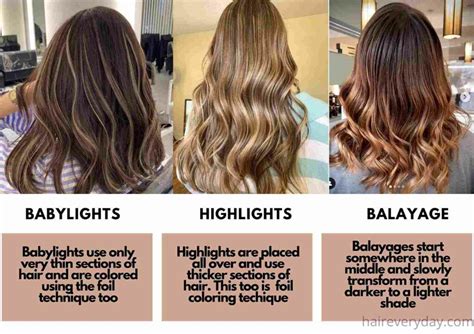When it comes to getting highlights or balayage, it can be tough to decide which one is right for you. Both techniques can give you a beautiful, sun-kissed look, but there are some key differences between the two.

Here’s a breakdown of the five key differences between highlights and balayage:
1. Application
Highlights: Highlights are applied to small sections of hair, using a foil or cap. The hair is then bleached or lightened to create a contrast with the rest of your hair.
Balayage: Balayage is a freehand technique where the color is painted onto the hair. This creates a more natural, blended look.
2. Placement
Highlights: Highlights can be placed anywhere on the head, but they are typically concentrated around the face and crown.
Balayage: Balayage is typically applied to the mid-lengths and ends of the hair. This creates a more subtle, sun-kissed look.
3. Color
Highlights: Highlights can be any color, but they are typically lighter than your natural hair color.
Balayage: Balayage can be any color, but it is typically blended with your natural hair color to create a more natural look.
4. Maintenance
Highlights: Highlights require regular touch-ups to maintain the contrast between the highlighted and non-highlighted hair.
Balayage: Balayage is a low-maintenance technique. The color will fade gradually over time, so you won’t need to touch it up as often.
5. Cost
Highlights: Highlights are typically more expensive than balayage. This is because they require more time and effort to apply.
Balayage: Balayage is typically less expensive than highlights. This is because it is a less time-consuming technique.
So, which one is right for you? If you want a dramatic, high-contrast look, then highlights are the way to go. If you want a more natural, blended look, then balayage is a better choice.
Highlights and balayage are two popular hair coloring techniques that can give you a beautiful, sun-kissed look. But what’s the difference between the two?
Here’s a breakdown of the key differences between highlights and balayage:
| Feature | Highlights | Balayage |
|---|---|---|
| Application | Small sections of hair are bleached or lightened using a foil or cap | Color is painted onto the hair freehand |
| Placement | Concentrated around the face and crown | Applied to the mid-lengths and ends of the hair |
| Color | Any color, but typically lighter than natural hair color | Any color, but typically blended with natural hair color |
| Maintenance | Regular touch-ups required | Low-maintenance |
| Cost | More expensive | Less expensive |
If you want a dramatic, high-contrast look, then highlights are the way to go. If you want a more natural, blended look, then balayage is a better choice.
Here are a few tips for choosing the right hair coloring technique for you:
- Consider your natural hair color and skin tone.
- Think about the style you want to achieve.
- Consult with a professional hairstylist.
Here are a few common mistakes to avoid when getting highlights or balayage:
- Don’t try to do it yourself.
- Don’t go too light or too dark.
- Don’t over-process your hair.
- Don’t use harsh chemicals.
Highlights and balayage are both beautiful hair coloring techniques that can give you a sun-kissed look. But there are some key differences between the two. Consider your natural hair color, skin tone, and desired style when choosing the right technique for you.
